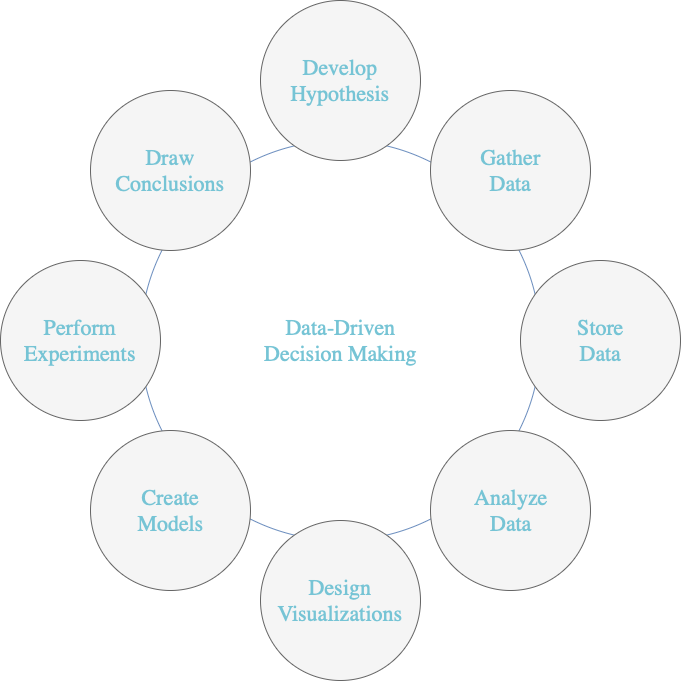The Digital Revolution is the most significant change in how businesses operate since the Industrial Revolution. Data is the driving force behind this revolution, and like electricity, it powers everything from analysis to machine learning. The exponentially increasing amount of data combined with the ubiquity of cloud computing has formed a perfect storm to transform business and society at large. Creating a data strategy is the best way for a company to take advantage, and companies that do not fully embrace the new paradigm will be outmaneuvered by their competitors and relegated to the dustbin of history.
So how does a company become data-driven? It happens when a company utilizes factual information as opposed to intuition to make business decisions. This approach provides several advantages. By sharing data across an organization decisions are more consistent and less contentious than using individual intuition. Data-driven decision making also helps avoid cognitive biases like ignoring evidence that creates dissonance with our existing views or expecting a complex process to behave in simple ways. Companies that leverage data will more successfully accomplish an objective; research conducted by the Sloan School of Business reveals companies that engage in data-driven decision-making experience a 6% increase in productivity and output.
Best in Class Examples of Data-Driven Companies
When you think of Chick-Fil-A, you think of friendly smiles serving famous chicken since 1946. But what you might not know is this traditional brand prioritized data-driven decision making which led them to great success. One of the ways they use data is by leveraging information the company knows about its highest-spending buyer: the soccer mom. By using data they collected along with publicly available datasets, Chick-Fil-A uncovered behavioral and demographic patterns that are consistent with soccer moms, and then compared those analytics with different demographic groups across the United States. With these pieces of information aligned, Chick-fil-A could confidently make decisions on where would be a successful location for a new restaurant.

Photo Credit: Pexels
Amazon is another great example of a data-driven company. The company utilizes data not only for all of its products and services, from the layout of the site to delivery logistics, but also for internal company decisions from where to locate its new headquarters to what color to paint the walls. One of the most successful ways Amazon leverages data is keeping track of the types of products certain customers continuously purchase and then using a machine learning recommendation system to push similar or complementary products to shoppers. This strategy improves the customer experience and ultimately increases sales.
This kind of data strategy is not just for the big brands; smaller companies can revolutionize their businesses as well. At stable|kernel, we use data in everything we do internally for employees and externally for clients. We build better client products based on data we gather from their actual app users through interviews and user testing; we use weekly internal surveys to let our executive team know how well we are functioning as a company and they take the feedback, analyze and strive for measurable improvement. We also track time and effort on client and personal projects to optimize teams and make sure we are working with maximal efficiency.
How to Get Started with a Data Strategy
The approach we take when helping our partners become data-driven begins by identifying the most important priorities and challenges related to their prospective businesses. This can be anything from improving customer satisfaction to increasing app user retention or reducing operational costs on manufacturing floors. Once a specific challenge is identified, the next step is to gather data. This could include demographics, usage patterns, transactional data, IoT data, behavioral data, or user-submitted content. It’s important to identify high-quality data that is directly related to the objective. Ultimately, the quality of the decisions made based on data is only as good as the quality of the data used to make those decisions. We like to use the phrase “garbage in, garbage out.”
Once data is gathered, it needs to be stored in a system that is secure, reliable, and scalable. Data security needs to be a critically important, fundamental focus of a good system design from the beginning, and should not be simply added on as an afterthought. Data systems are the foundation of a data-driven company and must be solid in order to be confidently built upon. To deal with the ever-increasing amounts of data being generated systems should be designed to scale well, so they don’t need to be redesigned every few years.

Data is a raw material which must be processed into the final product of knowledge before it is useful for decision making. The process of extracting knowledge from data is known as analysis, and analysis takes many forms and can range from simple statistical analysis like finding the average or outliers of a sample to complex machine learning models. During analysis, it is often useful to create visualizations like graphs or charts. Visualizations often reveal patterns and outliers and are an important tool in helping us understand large amounts of data efficiently. Models created during analysis let us see correlations between different variables and let us make predictions about the future.
Once the original round of analysis is complete, we validate our conclusions by performing experiments. Based on the results of the experiments we continuously iterate by asking new questions, gathering new data and performing more analysis. This continuous cycle of inquisition and discovery becomes more efficient as a company fully transitions to data-driven decision making. Over time, important visualizations are aggregated into dashboards, providing a simple way to see an overview of one or more business objectives. Useful models that have been validated continuously are set up to automatically generate alerts to notify stakeholders of anomalies in real time before they can become issues. Finally, machine learning and automation create even more efficiencies by providing continuous corrections and optimization.
Becoming data-driven requires a fundamental shift in a company’s culture and employee mindset. This change is best accomplished in a top-down manner, where leaders in the organization lead by example by making data-driven decisions transparently and openly. The time is now to invest in a data-driven strategy to ensure future success for your business. If you want to learn more about how stable|kernel works with our partners to become data-driven, feel free to reach out below.
 The SK Engineering Team
The SK Engineering Team